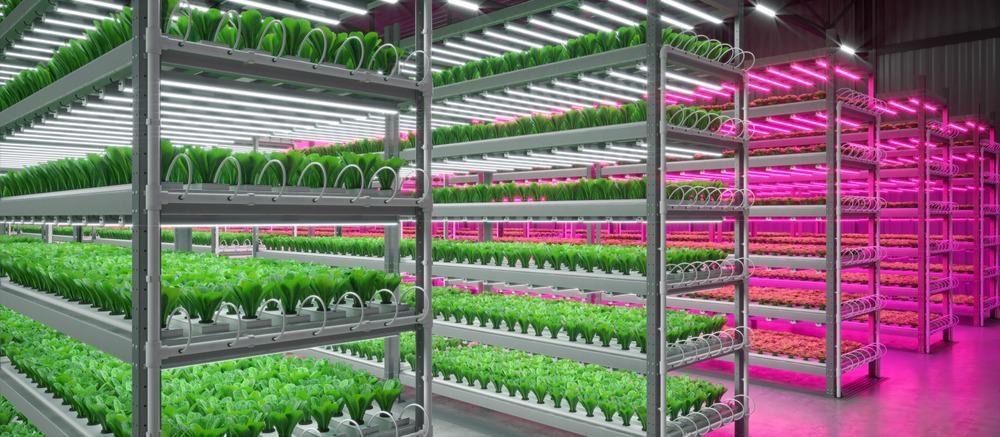With the ever-growing demand for food placing increased pressure on the Earth’s resources, innovators are re-examining the fundamentals of farming to create a new and sustainable food system. With the hopes of potentially transforming global food systems, many emerging start-ups have identified urban indoor farming as a viable alternative to conventional farming.

Image Credit: Nikolay_E/Shutterstock.com
Concerns with Traditional Farming
Traditional farms typically rely on herbicides, pesticides and fertilizers to grow crops, which can pollute the environment if used in excess. Up to 98% of a chemical spray will bounce off a crop instead of staying on the plant, resulting in chemicals accumulating in the soil and, eventually, waterways.
Biodiversity loss is another concern of conventional farming as the conversion of wild spaces to farmland has resulted in less space for wild plants and animals to live in. With the global population predicted to reach 9.7 billion by 2050, the agriculture industry is under pressure to scale up to meet these demands, which could potentially affect the natural environment further if nothing is done to rethink current farming practices.
With 40% of available global land already occupied by fields of crops and pastures for animals, it would be difficult to completely eliminate the impact that farms have on the natural environment. However, part of the answer could lie in indoor farming where growing conditions can be better managed, reducing the environmental impact of growing produce.
Indoor Farming Technology Market
The indoor farming technology market was valued at $14.5 billion in 2020 and is projected to reach $24.8 billion by 2026.
The contained facilities used in indoor farming allow farmers to better control and optimize growing conditions. This results in higher yields compared to traditional farming methods whilst using less land area. For example, the average yield of tomatoes grown using traditional methods was reported in 2016 to be 1.85 pounds per square foot, while the average yield of tomatoes grown from greenhouse hydroponics was 10.59 pounds per square foot. By increasing the growing area by stacking additional planting layers, the overall crop yield can be increased.
Indoor farming addresses the concern of limited arable land and water wastage. In vertical farming, the need for land can be reduced by a hundred-fold, and by recirculating and reusing water, an average of 95% less water is required for growing the same crops when compared to outdoor farming.
Vertical farming is one of the techniques used to grow crops within indoor environments. By using artificial light and vertical growing systems such as aeroponics, aquaponics and hydroponics, crops such as kale, lettuce, strawberries and herbs can be grown within a clinically clean indoor system without the need for soil, sunlight and pesticides. This technology allows vertical farms to be set up close to populous areas or urban hubs, where harvests can be distributed locally.
80 Acres Farms
80 Acres Farms operates vertical farms in eight locations across four states. Its farms produce crops using zero pesticides and consume 97% less water compared to traditional farms.
Using 100% renewable energy and being completely indoors, 80 Acres’ operation is capable of producing various crop varieties all year without the need to rely on favorable weather.
Sophisticated technologies, including AI sensors, are incorporated into its operation to ensure that growth environments are optimized according to the plants’ genetics and that harvests are at the peak of ripeness. By relying on a smaller delivery radius, customers are able to access the produce within a day of picking.
“80 Acres' farms are, on average, 300 to 400 times more productive than field farming”, says co-founder Mike Zelkind. This is due to the vertical structures used for growing produce, which allows room for more crops in less space as well as faster-growing produce.
80 Acres Farms- Vertical Farming at Scale
Video Credit: 80 Acres Farms/YouTube.com
Current Limitations of Indoor Farming
Apart from the high energy costs associated with operating vertical farms, there are also high investment costs for urban land and for the technologies and devices needed to carefully control and monitor the growing environment – these include aspects such as temperature, lighting, and pollination.
The high initial investment compared with traditional farming is a drawback for indoor farms, but this also invites the opportunity for innovation and the development of more cost-effective technologies.
Transforming Agriculture for the Future
Transforming farming in a way that does not affect the natural environment will be no small task, given the sheer scale of the world’s agriculture. With a growing demand for food, there is an ever-increasing pressure for high-yielding and sustainable farming techniques.
In addition to being a great use of spaces not traditionally utilized for agriculture, the high yields of pesticide-free indoor farms show great promise. Although indoor farming is unlikely to completely replace traditional field farming right now, it still has the potential to answer, at least in part, the question about food security in the years to come.
References and Further Reading
80 Acres Farms (n.d.). How it Works. [Online] 80 Acres Farms. Available at: https://www.80acresfarms.com/how-it-works/ [Accessed on 9 Jul. 2021].
Kateman, B. (2020). Is The Future Of Farming Indoors? [Online] Forbes. Available at: https://www.forbes.com/sites/briankateman/2020/07/14/is-the-future-of-farming-indoors/ [Accessed on 9 Jul. 2021].
Ogden, L. (n.d.). Follow the Food: The Clean Farming Revolution. [Online] BBC. Available at: https://www.bbc.com/future/bespoke/follow-the-food/the-clean-farming-revolution/ [Accessed on 9 Jul. 2021].
Singer, D. (n.d.). Follow the Food: How to Grow Food in a Concrete Jungle. [Online] BBC. Available at: https://www.bbc.com/future/bespoke/follow-the-food/how-to-grow-food-in-a-concrete-jungle/ [Accessed on 9 Jul. 2021].
Markets and Markets (n.d.). Indoor Farming Technology Market. [Online] Markets and Markets. Available at: https://www.marketsandmarkets.com/Market-Reports/indoor-farming-technology-market-40175861.html [Accessed on 9 Jul. 2021].
Disclaimer: The views expressed here are those of the author expressed in their private capacity and do not necessarily represent the views of AZoM.com Limited T/A AZoNetwork the owner and operator of this website. This disclaimer forms part of the Terms and conditions of use of this website.